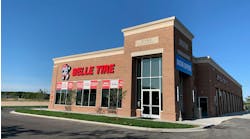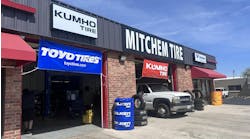Retail tire sellout was up slightly — by less than 1% — but it’s a gain for tire dealers over October 2024 results, and is largely similar to prior-month trends.
Independent tire dealers averaged sellout growth of 0.7% in November 2024, an improvement from the 1.7% decline in October 2024 and the trends that showed the third quarter was in the range of flat-to-down slightly.
Regional volume reports showed the Northeast and Midwest saw gains in the mid-single digits. Other parts of the country saw negative volume trends, with the Mid-Atlantic region showing the weakest market, and volumes down a significant 7.5% year-over-year.
Gains from the first snowfall
Dealers reported that the first part of November 2024 continued October’s trends, but when some winter weather arrived later in the month in the Northeast and Midwest, tire replacement was suddenly at the forefront of consumers’ minds.
We note that December 2024 had a slightly positive comparison, with retail sellout volumes that were up 1% year-over-year in December 2023. We wouldn’t be surprised to see those final figures show flat results.
The miles driven numbers were roughly flat in November 2024, following a low single-digit increase in the third quarter. Our Miles Driven Momentum Index registered a 0.3% year-over-year decrease in November, but that follows a robust 5.5% increase in October.
We believe miles driven trends were negatively affected by heavy snowstorms in the Great Lakes regions at the end of the month of November.
Throughout 2024, we consistently saw miles driven trends ahead of pre-pandemic trends and we expect to continue to see flat-to-slightly-elevated trends in the months ahead.
Natural rubber prices rise
In the world of raw materials, the cost of the basket of raw materials needed to build a basic replacement tire increased 5.4% in November 2024, year-over-year — and fell 0.2% from October levels. This follows a 10.5% year-over-year average increase during the third quarter, which followed a 9.5% year-over-year increase in the second quarter.
Holding raw material pricing steady would equate to a 5.8% year-over-year increase in the input costs to build a tire in the fourth quarter.
The cost of natural rubber remains the most volatile of the inputs and in November, that cost grew 41% year-over-year as supply remains pressured in Southeast Asia.
Synthetic rubber prices were also on the move up, with a 10.3% year-over-year increase for the month. Oil prices, carbon black and tire fabric/cordage all showed price drops in November — 13%, 3.2% and 6.1% respectively.
Dealers report demand
The commentary we gathered from tire dealers suggests consumer demand for passenger and light truck replacement tires was slightly positive for November 2024, when compared to November 2023. More than one-third — 37% - of independent dealers we surveyed saw positive demand trends in November, an improvement from the net negative 33% demand dealers reported to us in October 2024.
Consumer deferment and trade-down have been consistent themes overall several months and we believe that the early signs of winter weather prompted consumers to rush to get caught up on vehicle maintenance and tire replacement ahead of the winter season. Yet we note that consumers continue to trade down to tier-two and tier-three tires. Dealers continue to call out soft trends for premium, tier-one tire brands.
There’s proof of that trend in our look at the best and worst performers. Dealers indicate tier- three tiers were again the most in demand in November. That marked seven straight months at the top of the demand rankings.
This is different from our observed long-term trend, where tier-two tire brands have historically been the most popular in the decade-plus history of our survey. Tier-two brands were again in second place, while premium tier-one brands remained in last place for a third consecutive month.
This kind of stability in the mix is unusual. While we believe the November result to be an indication of the type of buyer in the marketplace, we traditionally see a high level of volatility in our month-to-month tier rankings.
Even with that, historically tier-two brands have risen to the top of demand for their balance of cost and performance characteristics.



